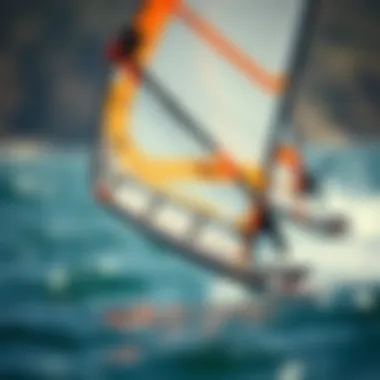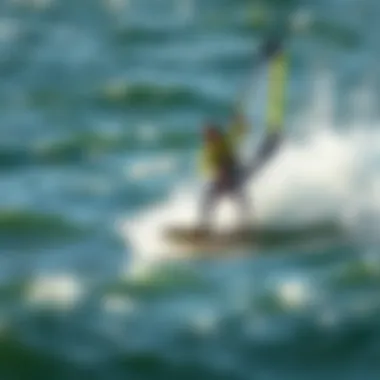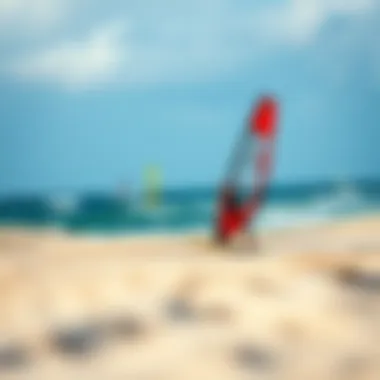Exploring the Dynamics of Windsurf Foils


Intro
Windsurf foils have transformed the windsurfing landscape over the past few years. This is not just about attaching a foil to a board and calling it a day; it goes much deeper. Understanding how they work and their influence on the sport can unlock a multitude of thrills on the water. In this article, we will dig into the intricate world of windsurf foils, analyzing their design, functionality, and the ripple effects they have on both the sport and the environment.
From the latest in foil technology to exploring the cultural significance of foiling, this piece aims to enlighten both newcomers and seasoned pros. By the end, you’ll not only have a richer insight into windsurf foils but also a newfound appreciation for the artistry and ingenuity behind them.
Windsurfing enthusiasts from various backgrounds can gain something from this journey. Whether you're looking to refine your skills, invest in new gear, or just want to fathom the dynamics involved, there’s plenty to cover here.
Understanding Windsurf Foiling
Windsurf foiling, while seemingly niche, is crucial for any serious windsurfer aiming to elevate their performance. This section breaks down the essentials of foiling, emphasizing its mechanics, benefits, and how it fundamentally alters the dynamics of windsurfing. Not everyone may be aware that foiling isn’t just about moving faster; it can transform a ride into something truly exhilarating, allowing for smoother navigation over rough waters. This understanding sets the tone for the remaining discussions.
What is a Windsurf Foil?
A windsurf foil is a sophisticated apparatus attached to the bottom of the windsurfing board. It consists of a mast, wings, and a fuselage which create lift when appropriate speed is achieved. This lift allows the board to rise above the water, drastically reducing drag and enhancing speed. Unlike traditional windsurfing, which steadies itself on the water’s surface, foiling offers a sensation of flying, increasing the thrill for enthusiasts. This technology has evolved to be lightweight yet sturdy, suitable for various conditions, fostering a robust community around it.
History and Evolution of the Windsurf Foil
The origins of the windsurf foil trace back to the late 20th century, emerging as a response to the demands for new techniques and exciting challenges on the water. The first attempts at foiling were clunky and inefficient, but through trial and error, designs improved significantly. Key innovators in the sport experimented with different materials and wing shapes, either carving through trial error or repurposing existing designs from kiteboarding and sailing. The real breakthrough came when manufacturers started using lighter materials, enhancing buoyancy and stability. Today, foiling combines engineering precision with a passion for windsurfing, representing the apex of both disciplines.
Mechanics Behind Foiling
To truly grasp the nuances of windsurf foiling, one must understand its mechanics. This section unpacks three fundamental concepts: hydrodynamic principles, lift and drag forces, and the effects of speed and angle in foiling.
Hydrodynamic Principles
Hydrodynamics plays a crucial role in foiling. At its core, it refers to the behavior of fluids in motion. In terms of windsurf foils, as the board moves forward, water flows over the wings, creating pressure differences. The key characteristic here is the shape of the wing. A cambered wing design leverages Bernoulli's principle—where faster-moving air above the wing creates lower pressure, lifting the board upwards. This principle showcases why choosing an optimal wing design is vital for effective foiling.
The unique feature of hydrodynamics in foiling is its efficiency at higher speeds, overcoming drag issues seen in traditional windsurfing. However, it doesn’t come without its challenges. A deeper understanding of hydrodynamic forces can prevent mishaps, ensuring that enthusiasts can maximize their airtime while maintaining control and stability.
Lift and Drag Forces
Lift and drag are the two forces at play in foiling—lift is what keeps you above water, while drag is the resistance that slows you down. It's a delicate balance. The main characteristic of lift in this context is its dependence on the angle of attack and speed. Adjusting the position of the board will influence these forces, thus enhancing speed and control. An increase in lift can propel the board higher, but if not controlled, it could lead to an unstable flight.
Conversely, understanding drag can lead to more streamlined designs and setups, reducing energy loss. The interplay of these two forces is fundamental in ensuring a smooth ride, making their mastery essential for anyone venturing into the world of windsurf foils.
Effects of Speed and Angle
Speed and angle directly impact performance in foiling. The angles at which the foil meets the water can either enhance lift or induce a stall, determining how effectively the board rises. Higher speeds typically provide more lift, but achieve too much can lead to an uncontrollable ride.
The key characteristic is that an optimal speed range can be achieved only through practice and adjustments in riding style and equipment setup. Different conditions affect what that speed range should be – strong winds enable faster riding while light winds require finesse.
Understanding these dynamics not only improves the enjoyment of foiling but also enhances safety. Learning how to maintain the right angle and adjust to changing conditions is part of what makes this sport both challenging and rewarding.
Components of a Windsurf Foil
Foil Parts and Their Functions
Fuselage Design
The fuselage serves as the backbone of the foil, connecting the wings and other components. Its design is crucial for balance and handling. A longer fuselage offers more stability, which is beneficial for beginner windsurfers. Conversely, a shorter fuselage can provide better responsiveness and agility for advanced riders. The lightweight yet robust materials used in modern fuselage designs not only enhance durability but also improve performance on the water.
One unique feature of contemporary fuselages is their ability to incorporate modularity. This characteristic allows for easy adjustments and customization, enabling sailors to tailor their equipment based on specific riding conditions and preferences. However, while a longer fuselage aids stability, it can also limit maneuverability in tight turns, which can be a drawback for some advanced techniques.
Front and Rear Wings
The wings are arguably the most critical parts of the foil assembly, as they generate lift and define the overall handling characteristics. The front wing's shape and area influence how much lift it produces; larger wings offer increased lift but can also introduce more drag. On the other hand, rear wings help maintain balance and fine-tune the ride's dynamics. A larger rear wing can give more control, while a smaller rear wing can yield faster speeds due to reduced drag.
What stands out about the front and rear wings is their ability to affect performance across different wind and water conditions. Choosing the right combination is essential, especially when considering that changing just one element can dramatically influence a rider's experience. However, offsetting lift with drag can become tricky; thus, enthusiasts must carefully evaluate their choices to achieve the optimal balance.
Stabilizers and Quality Materials
Stabilizers play an essential role in maintaining pitch stability and preventing unwanted movements during foiling. They allow riders to better control their altitude (height above water), which is crucial for a smooth and controlled ride. The materials used for stabilizers often include carbon fiber and other high-grade composites, ensuring they are light yet robust to withstand various conditions.
One notable aspect of stabilizers is that they come in various shapes and sizes; some are designed for high-speed performance while others prioritize stability. While incorporating high-quality materials offers advantages such as increased strength and lighter weight, they often come at a higher price point. A sturdy stabilizer can enable a foiler to push their limits on the water, but durability must be weighed against cost.
Choosing the Right Foil Setup


Finding the perfect foil setup can significantly enhance a sailor's enjoyment and performance in windsurfing. Understanding the interactions between size, weight distribution, and conditions is essential for selecting the right equipment, and each of these elements can have a profound impact on overall success on the water.
Size Considerations
Choosing the right size for a windsurf foil involves assessing the rider's weight, skill level, and intended conditions. A larger foil might suit heavier riders or those who primarily sail in light winds, providing them with the lift needed to get up and stay foiling. Meanwhile, lighter riders might opt for smaller foils, allowing for quick maneuverability and more responsive handling.
Often, beginners are encouraged to start with a larger size because it simplifies the learning process. However, if too large of a foil is selected, it can lead to excessive lift, making control difficult on choppy waters. Hence, having the right size is paramount for both comfortable handling and performance efficiency.
Weight Distribution
Weight distribution is another profound aspect that can affect how well a foil performs. Proper positioning of body weight has a direct impact on lift and control while foiling. If a rider's weight is too far back, the foil can stall, making it hard to generate lift. Conversely, if positioned too far forward, it may cause the foil to dig into the water, which can be equally problematic.
Many riders experiment with different stances and their weight distribution to discover what works best for them. This exploration can lead to enhance control and stability when sailing. However, it sometimes requires patience and practice, as every rider is unique and may necessitate distinct adjustments.
Conditions and Skill Level
The general conditions in which someone intends to windsurf or foil can dictate the kind of setup they should consider. For example, foiling in light winds typically demands a different setup compared to sailing in stronger winds. Beginners may find it beneficial to practice on calmer days to develop their skills without the added challenge of strong winds.
Skill level also dictates equipment choice. Novices should often opt for setups that lend themselves to stability and ease of use, while advanced riders may explore setups that allow them to push the limits of speed and agility. The balance between rider skill and conditions is vital for ensuring a fulfilling and safe windsurfing experience.
In summary, understanding the components of windsurf foils and choosing the right setup can lead to significant improvements in performance and overall enjoyment on the water. Each aspect, from the fuselage to wing sizes, plays a crucial role in the overall dynamics of a windsurf foil, making informed decisions essential for both novices and veterans.
Benefits of Windsurf Foiling
Windsurf foiling has gained significant traction among water sports enthusiasts, and its benefits can’t be overstated. The very essence of this technique intertwines performance and adventure, renewing the way windsurfing is perceived. As we dive into the advantages, one can’t help but notice how foiling expands the horizons of the typical windsurfing experience.
Performance Enhancement
Increased Speed
The first noticeable benefit is the increased speed that foiling provides. This is mainly due to the reduced drag when compared to traditional windsurfing setups. Riders gliding above the water’s surface face less friction, allowing for swift transitions and thrilling rides. The key characteristic of this speed is the ability to harness wind power more effectively, turning even gentle breezes into exhilarating runs.
However, with great speed comes the need for caution; precision becomes vital when maneuvering. That said, the unique feature of acceleration while foiling contributes immensely to its appeal, making it an almost addictive choice for those eager to push their limits.
Better Maneuverability
The second aspect is better maneuverability. Foils enable boarders to change direction with agility, responding instantly to shifts in wind and wave patterns. Riders can carve through turns with greater fluidity, navigating tight spaces that were once challenging. This quality is especially beneficial in competitive scenarios where precision counts.
Moreover, the unique feature of enhanced turning capabilities means a windsurfer can adapt their style on the fly. Still, one shouldn't underestimate the necessity of practice; mastering this skill can take time. But that journey is worthwhile, enriching one's experience and broadening one’s repertoire.
Reduced Drag in Various Waters
Lastly, let’s discuss reduced drag in various types of water conditions. Foil boards are designed to lift above the surface, lessening the impact of waves or choppy water. This characteristic allows for enjoyable rides even when conditions are less than ideal. Riders can venture out in places they normally might not due to weather conditions.
While this feature sounds solely advantageous, it does come with some drawbacks; beginners may find these setups tricky to navigate. Nevertheless, the overall advantages of reduced drag far outweigh challenges, opening up possibilities to explore diverse locales.
Expanding Windsurfing Opportunities
Light Wind Performance
Transitioning to another segment, the light wind performance has become a game-changer for many. Foils can catch the lightest of breezes, transforming even the calmest days into thrilling adventures. This capability means that enthusiasts aren't confined to waiting for strong winds and can surf whenever they get the chance. The key characteristic here is accessibility, essentially democratizing the sport.
However, success in light winds requires specific gear and skills. It can sometimes be challenging to get everything aligned just right. The unique feature of this low-wind adaptability opens doors to undiscovered potential in places where traditional windsurfing could fall flat.
Exploring New Locations
Moreover, exploring new locations becomes far easier. With foiling, riders find themselves on previously uncharted territory—be it lakes, rivers, or coastal areas. The versatility of the equipment allows enthusiasts to redefine their journey. Unlike traditional windsurfing, which may be hindered by location, foiling opens up vast opportunities for exploration.
This newfound freedom does have its challenges; not all waters may be suitable for foiling. Local regulations or environmental factors can affect where one can ride as well. Yet, the thrill of discovering new spots makes the hunt worthwhile.
Greater Range of Conditions
Finally, there’s greater range of conditions that foilers can tackle. With conventional windsurfing, certain windy or wave-heavy days could spell trouble for a standard setup. Foils offer the chance to ride hydro dynamically, expanding not just the physical range but also the stylistic possibilities.
The unique feature of adaptability to varying conditions makes foiling equally exciting for both beginners and seasoned riders. Yet, as with many sports, mastering these adaptable techniques remains a key factor; newcomers to the sport must be prepared to put in the effort to reap the benefits of this flexibility.
Windsurf foiling indeed paves the way for enhancing performance and exploring the world around us, making it an invaluable addition to the windsurfing community.
Advanced Techniques and Skills in Foiling


Mastering windsurf foiling requires a deep understanding of not just basic skills but also advanced techniques that enhance a rider's performance and enjoyment. These advanced skills open up new possibilities for creativity on the water and can significantly impact how one interacts with the elements. By pushing the boundaries of traditional windsurfing, these techniques enable riders to explore their craft further, whether it's carving through waves, performing stunts in the air, or seamlessly riding downwind with control. Let's break down these skills into digestible pieces, focusing on both foundational aspects and the nuances that define mastery in foiling.
Basic Foiling Techniques
Correct Stance and Balance
The concept of stance and balance is as fundamental to foiling as it is to any other sport involving dynamic movements on a board. A proper stance ensures that a rider can distribute their weight effectively across their feet, which is crucial for maintaining control and stability. Riders are often advised to adopt a slightly crouched position, keeping the knees flexed while leaning forward. This not only allows for better balance but also helps in generating lift by adjusting body weight as needed.
A notable characteristic of this correct stance is adaptability. As conditions change—be it gusty winds or choppy waters—riders must be able to tweak their body positioning swiftly. The advantage here is clear; maintaining balance facilitates easier transitions into more advanced moves later. Additionally, experienced riders find that a correct stance minimizes fatigue during extended sessions due to optimized weight distribution. Still, it can be tricky for beginners; overcommitting weight forward or to the sides can lead to falls, making it essential to practice often.
Launching from Water
Launching from the water is a crucial step that separates proficient windsurfers from those who are just getting their feet wet. It’s about timing and technique—finding the right moment to lift the foil out of the water after a brief take-off on the board.
Key here is the rider's ability to read the wind and water conditions; a poor launch can lead to an unstable ride or an abrupt crash. Positioned correctly, a rider can push against the windward side of the board and use their body weight to initiate the lift. What makes this maneuver so beneficial is the momentary thrill as riders become airborne, providing a taste of the performance potential of foiling.
However, launching does not come without challenges. A rider must contend with varying depths and currents, meaning practice is essential. Those who get it right can become adept very quickly, while others might find frustration in repeated mishaps—this dichotomy can define whether someone pursues foiling with low enthusiasm or with great passion.
Controlling Lift
Once a rider is in the air, controlling lift becomes paramount. It is less about brute strength and more about finesse and awareness. Foils can generate lift at various angles, and a rider's job is to manipulate their stance to ensure the board stays level and stable.
The capacity to control lift relies heavily on adjustments in weight and lean; riders can shift their center of gravity to adapt to the speed and conditions around them. Riders often describe this responsiveness as a dance—they must continuously assess and adapt to maintain the desired height above the water’s surface.
While mastering this skill, the payoff is substantial. It allows riders to glide over water as if flying, offering breathtaking freedom during sessions. Yet, it's not without its downsides; miscalculating lift can lead to unwanted descents or even crashes, so staying connected to the board is vital.
Progressing to Advanced Skills
Carving Turns
Carving turns is one of the cornerstones of advanced foiling, distinguishing skilled riders from novices. A proper carve involves directing the board into a turn using both weight distribution and proper foot placement. Riding against the natural curve of the water, surfers can build momentum while continuing to slice through waves.
The feature of a well-executed carve is the smoothness with which it can transition into subsequent maneuvers. This fluidity not only feels rewarding but also contributes positively to speed, allowing quick direction changes without losing too much lift. Carving turns also empowers riders with the ability to explore wide arcs around obstacles in their path, enhancing their overall riding experience. Nevertheless, the thrill of carving comes with a fine line; turning too sharply can lead to a spill, making diligent practice and technique imperative.
Jumping and Freestyle Moves
Jumping and freestyle moves showcase the artistic and technical excellence that foiling can achieve. The fundamental idea behind these actions is to incorporate both launch techniques and lift control in a spontaneous and creative way. Riders often perform jumps to gain altitude, spinning or flipping mid-air—these stunts not only enhance the spectacle but also solidify a rider's presence in the windsurfing community.
What makes this skill set attractive is the realm of possibilities it offers; every jump creates a chance for personal expression. However, mastering these techniques can be daunting. Each jump demands precise timing and coordination, and hydraulic moments during the air can dictate success. The unique thrill of landing properly after an ambitious trick is a reward that fosters dedication to honing these skills.
Downwind Techniques
For many windsurfers looking to experience varied conditions, mastering downwind techniques is essential. Riding downwind can be exhilarating, minimizing resistance while allowing the rider to harness the prevailing winds for a fast-paced ride. The central idea revolves around adjusting the foil's angle and the rider's stance to maximize efficiency.
The most significant aspect of downwind techniques is navigation. Mastering the art of steering downwind allows for a blend of excitement and control, leading to long runs where windsurfers can find their rhythm. However, challenges exist; oversteering or miscalculating waves can lead to unwelcome losses of control. Still, mastering downwind techniques can add another layer of complexity and fun to any session.
The Cultural Impact of Windsurfing
Windsurfing is not merely a sport; it’s a vibrant culture that intertwines with communities, lifestyles, and environmental concerns. Exploring this dimension of windsurfing unveils its significance in shaping social bonds and encouraging eco-consciousness. It’s more than just riding the waves; it brings people together in ways that elevate individual experiences to collective memories.
Windsurfing as a Lifestyle
Community and Events
The heart of windsurfing beats in its communities —an eclectic mix of novices, seasoned pros, and those who just enjoy the thrill. Events such as competitions, regattas, and beach gatherings offer a venue for enthusiasts to mingle. This camaraderie builds a sense of belonging, fostering friendships that often extend beyond the sport.
The key characteristic of these events is their inclusivity. Whether you are a seasoned windsurfer or have just set foot on a board, the atmosphere is welcoming, allowing everyone to share tips, laughter, and stories. Such gatherings are not just competitions but celebrations of skills, often showcasing local culture through music, food, and art.
A unique feature of these communities is their ability to bridge geographical divides. Participants often travel for events, creating a melting pot of cultures around shared passions. The downside? Organizing events can sometimes be a logistical nightmare, from ensuring safety to managing diverse skill levels.
The Artistic Aspect of Windsurfing
Windsurfing transcends athleticism; it is an art form. The dance between the wind and the water can be stunning, where each move becomes a brushstroke on nature's canvas. Photographers and videographers gravitate towards the sport, capturing breathtaking moments that showcase the dynamic beauty of foiling.
Artistic expression in windsurfing emerges through styling and performance. Riders often combine techniques in mesmerizing ways, presenting a challenge that goes beyond just navigating the water. This element of creativity breathes life into competitions, with judges evaluating not only speed but also the flair of the performance.
A notable aspect is the influence of visual art in promoting the sport. Many windsurfing brands collaborate with artists to create unique designs for boards and sails, highlighting the intersection of sport and art. Despite this, the transient nature of live performances can make it tough to capture the essence of an artistic moment in windsurfing — a challenge that artists continue to confront.
Travel and Exploration


Windsurfing often turns life into an adventure; it facilitates the pursuit of exploration across diverse locations. Riders seek not just the thrill of the sport but the chance to discover new coasts, wind patterns, and cultures. The key characteristic of windsurfing travel is its ability to transform any trip into an opportunity for adventure.
Traveling to windsurf opens doors: each new locale brings different conditions, enhancing the thrill and adaptability of a rider. This aspect often leads to a deeper connection with nature and an appreciation for the environments visited.
Yet, the unpredictable nature of travel can lead to unforeseen challenges — equipment may get lost, or locations may not meet expectations. However, these hurdles often add to the allure, making for stories that windsurfing enthusiasts cherish.
Environmental Considerations
Sustainability in Equipment Manufacturing
The moving force behind windsurfing culture also encompasses a commitment to environmental stewardship. As enthusiasts venture into nature, there’s an increasing commitment to sustainable practices in equipment manufacturing.
Companies are innovating with materials like recycled plastics and eco-friendly production techniques. This effort reflects a broad beneficial choice for the community because it aligns with the values of many windsurfers who care for the oceans they enjoy.
Unique advantages of sustainable manufacturing include elevating brand reputation while reducing ecological footprint. However, sustainable materials can often come at higher costs, which might discourage some manufacturers from making the switch.
The Role of Windsurfers in Conservation
The windsurfing community often takes an active role in conservation efforts, leading initiatives aimed at preserving marine environments. By understanding how their actions impact the oceans, windsurfers can champion important causes.
This shared responsibility fosters a proactive attitude. Key characteristic is the organization of clean-up events, where windsurfers unite to protect beaches and waterways. Such actions enhance the visibility of conservation issues within the windsurfing sphere, galvanizing individuals to contribute to meaningful change.
However, while most of the community is engaged, some might see environmental advocacy as a secondary concern; thus creating a need for ongoing education and motivation.
Ethical Travel Practices
Ethical travel practices complement the windsurfing lifestyle. Riders are encouraged to impact destinations positively, respecting local customs and focusing on sustainable tourism. This mindset nurtures relationships with host communities, aligning perfectly with the ethos of windsurfing.
An essential aspect of this approach is the emphasis on leaving locations better than found. A beneficial and popular choice in this context includes supporting local businesses and participating in cultural exchanges. However, challenges arise as not all windsurfers are informed about local practices, potentially leading to misunderstandings.
Future Trends in Windsurf Foiling
Windsurf foiling represents a thrilling advancement in the sport of windsurfing, blending traditional sailing with innovative design. The evolving trends in foiling promise not only to enhance performance but also to change how enthusiasts engage with the sport entirely. Understanding these trends is crucial for anyone looking to improve their skills, select appropriate gear, or simply stay updated on the sport's developments.
Technological Innovations
Materials and Design Advances
Recent developments in materials and design have transformed windsurf foils. Manufacturers today utilize lightweight composites, which significantly reduce overall foil weight without compromising durability. This characteristic is especially beneficial for people who chase speed and agility on water. The unique feature of these advanced materials is their ability to maintain rigidity while being incredibly light.
This means that sailors can experience better lift and control. For instance, using carbon fiber reinforced structures is increasingly common. It enhances not only performance but also longevity against the wear and tear of saltwater. However, it's worth noting that these materials can sometimes come with a higher price tag, making them less accessible for beginners.
Performance Enhancement Technologies
Volatile winds and varied water conditions demand adaptable performance enhancement technologies. Newer foils combine multiple innovations that cater to different skill levels. One pivotal element of these technologies is their adjustable wingspan. This allows riders to tweak their foil based on current wind conditions, enhancing their riding experience.
For advanced riders, this provides a significant edge, helping them optimize their setup for maximum performance. Yet, one downside is the added complexity; adjusting foil configurations may be overwhelming for novices, potentially posing a steep learning curve.
Integration with Digital Tools
The rise of digital integration in windsurf foiling is a game changer. Today, sailors can utilize smartphone apps to monitor their performance metrics, adjust their gear settings, and even analyze their riding techniques. The ability to see data on speed, distance, and lift can refine a sailor’s approach, enabling them to make informed choices on the water. It's a compelling addition that underscores the blend of sports and tech.
On the flip side, reliance on technology might detract from the raw experience of windsurfing for some. Traditionalists may argue that too many gadgets can take away the essence of connecting with nature.
The Growing Popularity of Foiling
Rising Stars and Competitions
The competitive scene for windsurf foiling is rapidly gaining momentum. New talents are emerging from all corners of the globe, sparking excitement among fans and aspiring athletes alike. Athletes participating in competitions push the boundaries of what's possible in foiling, inspiring upcoming talent to elevate their game.
Competitions in diverse locations are drawing attention, providing spectators with engaging experiences. Moreover, such events promote community spirit among enthusiasts. However, as competitions become fiercer and more frequent, they may overshadow casual participation, potentially leading to a divide within the community.
Foiling in Varied Disciplines
Windsurf foiling is not limited to traditional racing or recreational sailing; it's branching out into different styles and disciplines. More riders are experimenting with freestyle moves, wave riding, and even downwind racing, expanding the horizons of what foiling can encompass. This diversification enriches the overall windsurfing culture, attracting a broader audience.
The unique feature of this growth is its ability to cater to riders of all interests, ensuring something for everyone. Nevertheless, it can complicate the learning process as diverse techniques and tricks require different approaches and skill sets.
Global Participation Trends
As word spreads about the exhilarating nature of foiling, global participation is on the rise. Countries that once had a modest windsurfing presence are now diving headlong into the foil phenomenon. This growing community is bolstered by social media, where enthusiasts share experiences, tips, and inspiration, bridging geographical gaps.
One of the key takeaways from this trend is the increased accessibility of the sport, thanks to affordable beginner options. But, there lies a challenge: as the community expands, ensuring that sufficient education and safety measures are in place is essential for promoting a safe environment for newcomers.
In summary, the future of windsurf foiling is bright, with various trends that promise to revolutionize the sport and enhance the sailor's experience. Each advancement brings its own set of considerations, urging enthusiasts to navigate the exciting journey of windsurf foiling with awareness.















